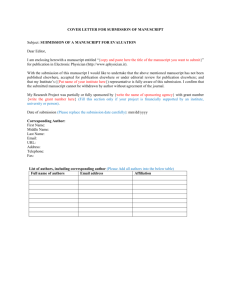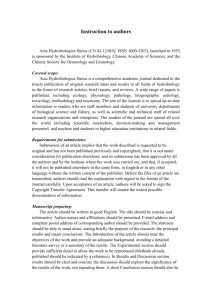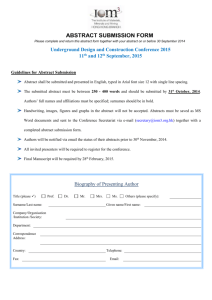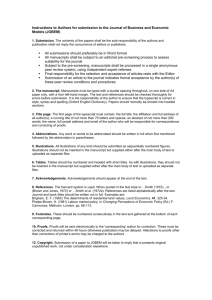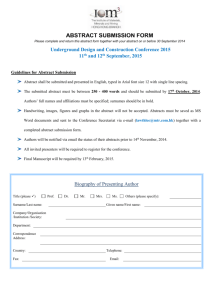Word
advertisement
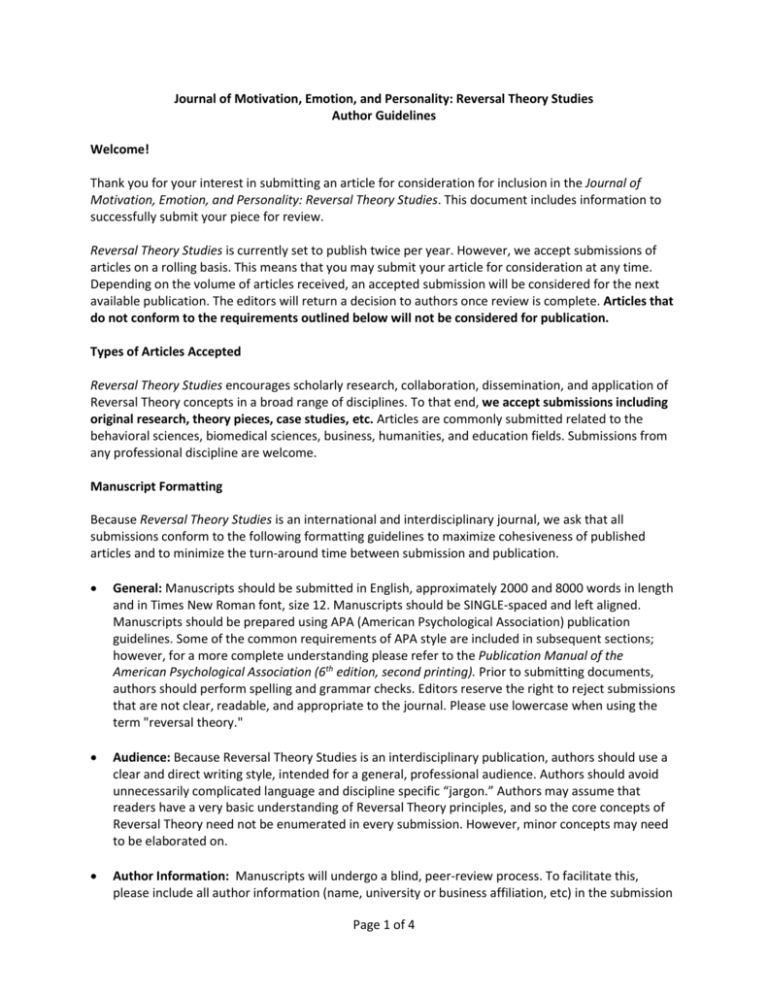
Journal of Motivation, Emotion, and Personality: Reversal Theory Studies Author Guidelines Welcome! Thank you for your interest in submitting an article for consideration for inclusion in the Journal of Motivation, Emotion, and Personality: Reversal Theory Studies. This document includes information to successfully submit your piece for review. Reversal Theory Studies is currently set to publish twice per year. However, we accept submissions of articles on a rolling basis. This means that you may submit your article for consideration at any time. Depending on the volume of articles received, an accepted submission will be considered for the next available publication. The editors will return a decision to authors once review is complete. Articles that do not conform to the requirements outlined below will not be considered for publication. Types of Articles Accepted Reversal Theory Studies encourages scholarly research, collaboration, dissemination, and application of Reversal Theory concepts in a broad range of disciplines. To that end, we accept submissions including original research, theory pieces, case studies, etc. Articles are commonly submitted related to the behavioral sciences, biomedical sciences, business, humanities, and education fields. Submissions from any professional discipline are welcome. Manuscript Formatting Because Reversal Theory Studies is an international and interdisciplinary journal, we ask that all submissions conform to the following formatting guidelines to maximize cohesiveness of published articles and to minimize the turn-around time between submission and publication. General: Manuscripts should be submitted in English, approximately 2000 and 8000 words in length and in Times New Roman font, size 12. Manuscripts should be SINGLE-spaced and left aligned. Manuscripts should be prepared using APA (American Psychological Association) publication guidelines. Some of the common requirements of APA style are included in subsequent sections; however, for a more complete understanding please refer to the Publication Manual of the American Psychological Association (6th edition, second printing). Prior to submitting documents, authors should perform spelling and grammar checks. Editors reserve the right to reject submissions that are not clear, readable, and appropriate to the journal. Please use lowercase when using the term "reversal theory." Audience: Because Reversal Theory Studies is an interdisciplinary publication, authors should use a clear and direct writing style, intended for a general, professional audience. Authors should avoid unnecessarily complicated language and discipline specific “jargon.” Authors may assume that readers have a very basic understanding of Reversal Theory principles, and so the core concepts of Reversal Theory need not be enumerated in every submission. However, minor concepts may need to be elaborated on. Author Information: Manuscripts will undergo a blind, peer-review process. To facilitate this, please include all author information (name, university or business affiliation, etc) in the submission Page 1 of 4 email or in a separate document. The editor will re-integrate this information with your manuscript at the time of publication, if accepted. Title Page: The title page typically includes the title, running head, author, byline, institutional affiliation, and author note (which includes grant/funding information and a full correspondence address). However, only the title, running head, and page number should appear on the manuscript submission. The title should be centered on the page, both vertically and horizontally, and appear in upper and lower case characters. The running head (maximum of 50 characters) should appear in the header, flush left, and the page number (title page is numbered “1”) should appear in the header, flush right. The author, byline, and institutional affiliation should appear ONLY in a separate document or in the submission email. These items will be added in by the editors after the blind peer review process, should the submission be accepted. Abstract: The abstract should be a brief, comprehensive summary of the contents of the article, including primary results and discussion if the paper is an original research article. The abstract should appear on the second page and be no longer than 250 words. Keywords: Keywords follow the abstract on page 2. Please limit your keywords to 5 words or short phrases. This will help researchers to find your article when searching catalogued databases. Body/Sections: The body of the submission should begin on page 3, with a reiteration of the Title, centered, in upper and lower case letters, unbolded. If the submission is a report of original research, it should include the following sections: (1) A review of the relevant literature, which begins immediately after the title, with no heading; (2) Method, which should be formatted as a Level 1 heading (see more about headings in the paragraph below). The Method section will likely include subheadings including participants, procedure, instruments, etc.; (3) Results, which should be formatted as a Level 1 heading, and which should include any appropriate tables; and (4) Discussion, also a Level 1 heading. If the submission is a book review, theory piece, clinical case presentation, etc., headings will certainly differ accordingly. Headings in APA style are formatted as follows. While virtually all papers will have at leave Level 1 headings, it is unusual for submissions to have all five levels of heading. Use the levels as appropriate to help improve clarity and readability for the audience, and to avoid lengthy or overreaching transitions. Page 2 of 4 Source: American Psychological Association. (2010). The publication manual of the American Psychological Association (6th ed). Washington, D.C.: Author. Citations: In-text citations should be in (Author, Year) format. Generally, the first appearance of a reference citation includes the last names of all authors and the year, while subsequent citations of the same work may use “et al.” Special guidelines apply for references with more than authors, no authors, etc. Citations may include page numbers, even for paraphrased material; page numbers are required for quotations. References: List references in alphabetical order. Each listed reference should be cited in text, and each in-text citation must be included in the References section. Each reference should be marked by a hanging indent of ½ inch. You MUST include the DOI where one is available. Examples of basic reference formats: Journal Article: Giraudeau, C., Chasseigne, G., Apter, M. J., & Mullet, E. (2007). Adults’ lay views about intelligence: A Reversal theory approach. Personality and Individual Differences, 42(1), 169-179. doi: 10.1016/j.paid.2006.07.004 Authored Book: Apter, M.J. (2005). Personality dynamics: Key concepts in reversal theory. Loughborough, UK: Apter International Ltd. Chapter in an Edited Book Svebak, S., & Martin, R. A. (1997). Humor as a form of coping. In S. Svebak & M. J. Apter (Eds.), Stress and health: A reversal theory perspective (pp. 173-184). Washington D.C.: Taylor & Francis. Page 3 of 4 Illustrations, Tables, & Figures: Insert illustrations, tables, and figures as you would like them to appear in the article. Use Word's Insert Table function when you create tables. Using spaces or tabs in your table will create problems when the table is typeset and may result in errors. For more information, refer to http://www.apastyle.org/learn/index.aspx or to the Publication Manual of the American Psychological Association (6th edition, second printing). To view a sample paper in APA style, please view http://www.apastyle.org/manual/related/sample-experiment-paper-1.pdf. This can be of tremendous value in preparing your manuscript. File Formats: Manuscripts should be submitted in .doc or .docx format, compatible with Microsoft Word, version 97 and above. Submission Process Manuscripts should be submitted electronically by email to journal@reversaltheory.net. A cover letter or e-mail should be included with the manuscript, providing the name and contact details of the author(s), including the mailing address, phone, fax, e-mail, and institutional affiliation. Please do not submit your manuscript to another journal while it is under review with Reversal Theory Studies. It remains appropriate for you to use your unpublished article informally while it is under review, for example, sharing your data with colleagues or students, posting your article on your personal or business website (listed as under review with Reversal Theory Studies), etc. Peer Review/ Timeline: Once submitted, the editor will remove your identifying information (contained in a separate document), and send your manuscript to TWO peer-reviewers in the discipline of the submission. Each reviewer will propose to: (1) accept the submission as is, (2) accept the submission with stated revisions, (3) request the author to revise and resubmit, or (4) not accept the submission. If there are conflicting proposals, the editor will make a final determination. The Editor will inform you of the status of your submission once the review has been completed. Once your article has been accepted, the editing team reserves the right to make formatting changes and copyedits to your article before publication. No substantial changes will be made to your submission. If substantial changes are required, you will be informed and requested to make those changes and resubmit. Copyright Information As the author of the article, the copyright to your published paper belongs to you. It is your responsibility to obtain copyright clearance for any copyrighted material contained within your article. Authors that have articles published in this journal agree that the article is governed by an open access Creative Commons Attribution, No Derivative Works license (CC BY-ND 3.0). Under the terms of this license, authors retain ownership of the copyright of their articles. Any redistribution, commercial and non-commercial, is allowed as long as the article is passed along unchanged and in whole, with credit to the author. Page 4 of 4

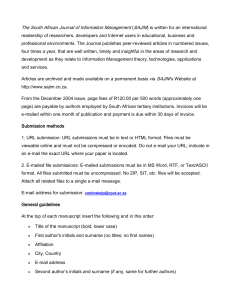
![Abstract Submission form – University of Kent [4]](http://s3.studylib.net/store/data/006978975_1-efbec71d82067924b8838e608fcd0114-300x300.png)
